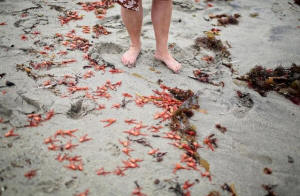|
Red tuna crabs carpet Southern California
beaches again
 Send a link to a friend
Send a link to a friend
[May 17, 2016]
By Steve Gorman
LOS ANGELES (Reuters) - Masses of tiny red
crustaceans known as tuna crabs have washed up for a second straight
year along stretches of the Southern California shoreline in a
phenomenon marine scientists say is linked to warmer ocean currents
flowing up the coast.
|

Thousands of red tuna crabs are shown washed ashore in Dana Point,
California June 17, 2015. REUTERS/Sandy Huffaker/Files |
|
 Waves of the dead or dying tuna crabs have been found carpeting
the sand at various San Diego and Orange County spots, including
Imperial, Huntington and Newport beaches, since the middle of last
week. Waves of the dead or dying tuna crabs have been found carpeting
the sand at various San Diego and Orange County spots, including
Imperial, Huntington and Newport beaches, since the middle of last
week.
The crabs are typically concentrated in Mexican waters off the
southern and central Baja Peninsula, but warming currents
periodically carry the crustaceans farther north and closer to
shore, according to scientists.
The latest event and a similar mass stranding of tuna crabs last
June along beaches from San Diego to Orange County coincided with
the El Nino effect, which alters ocean temperatures and currents in
the eastern Pacific.
 Also known as pelagic red crabs, the bright salmon-colored creatures
resemble small lobsters or crayfish, measuring 1 to 3 inches
(2.5-7.5 cm) in length.
They are a favorite delicacy of some species of tuna, hence their
common name. Their scientific name is Pleuroncodes planipes.
Unlike most crabs, they largely spend their lives grazing on
phytoplankton as they swim freely in open water rather than crawling
along the sea floor, though larger adults will make excursions to
the bottom, according to the Scripps Institution of Oceanography in
San Diego. Because they live in the water column, the crabs drift
with the winds, tides and currents.
[to top of second column] |

Linsey Sala, a Scripps scientist, said the latest influxes of the
tuna crab appear to have established a longer-term population of the
crustaceans that may linger in the waters off Southern California
for a number of years.
Scientists advise the crabs are not safe for human consumption
because they may have ingested toxin-producing plankton.
(Reporting by Steve Gorman; Editing by Jonathan Oatis and Sandra
Maler)
[© 2016 Thomson Reuters. All rights
reserved.]
Copyright 2016 Reuters. All rights reserved. This material may not be published,
broadcast, rewritten or redistributed.
 |